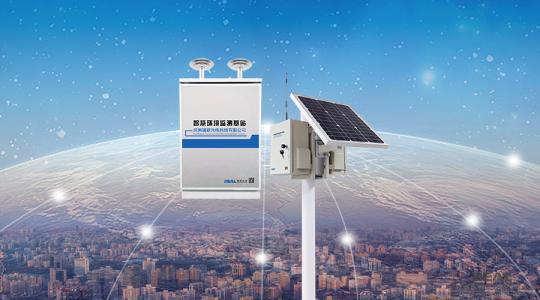In environmental protection systems, it is often necessary to monitor numerous pollution emission points in real time, and most of the monitoring data needs to be sent to the back-end server of the management center for processing in real time. Since monitoring points are dispersed and widely distributed, and most of them are located in areas with harsh environments, transmitting data through telephone lines often results in half the effort. Data transmission through GPRS wireless network has become one of the communication methods chosen by environmental protection departments. Pollution source monitoring equipment can send collected pollution data and alarm information to the environmental monitoring department in a timely manner through the GPRS network, enabling timely management of pollutant-discharging units or individuals, which can greatly improve the work efficiency of the environmental protection department.


The environmental protection data collection system is a pollution source monitoring system composed of pollution source emission monitoring points and monitoring centers. The system can automatically sample pollution sources and conduct online monitoring of major pollution factors; grasp the emission status of urban pollution sources and the total amount of pollution source emissions, and automatically transmit the monitoring data to the environmental protection monitoring center; the computer in the monitoring center can perform data summary, sorting and comprehensive analysis ; Monitoring information can be transmitted to the Environmental Protection Bureau, which will supervise and manage pollution sources.
Pollution source monitors are installed at each pollution source emission monitoring point to monitor pollution sources. The monitoring center receives the monitoring information transmitted by the monitoring points; and is responsible for classifying, screening and comprehensively analyzing the monitoring information. As the decision-making center of the system, the Environmental Protection Bureau analyzes and investigates the monitoring information obtained from the monitoring center station, makes timely management decisions, and increases management intensity.
The GPRS communication network can provide wide-area wireless IP connections. Building an environmental protection information collection and transmission system on the GPRS business platform to realize wireless data transmission of environmental protection information collection points has the advantages of making full use of the existing network, shortening the construction cycle and reducing construction costs. , and the equipment is easy to install and simple to maintain.
The GPRS DTU wireless environmental pollution source online monitoring system has the following characteristics:
1. Wide monitoring range
The GPRS network has achieved nationwide coverage, with unlimited expansion and unlimited access locations, and can meet the access needs of mountainous areas, towns and across regions. Due to the large number of environmental protection information collection points distributed throughout the province, some environmental protection information collection points are located in remote areas and are geographically dispersed. Therefore, using GPRS network is the ideal choice.
2. High reliability
Compared with SMS short message method, GPRS DTU adopts connection-oriented TCP protocol communication, which avoids the phenomenon of data packet loss and ensures reliable data transmission. The center can transmit data to multiple monitoring points simultaneously without interfering with each other. The GPRS network itself has a complete frequency division multiplexing mechanism and extremely strong anti-interference performance, completely avoiding the multi-machine frequency band “collision” phenomenon of traditional data transmission radio stations.
3. Strong real-time performance
GPRS has the characteristics of real-time online, small data transmission delay, and supports simultaneous transmission of multiple points. Therefore, the GPRS monitoring data center can conduct two-way communication between multiple monitoring points quickly and in real time, which satisfies the system’s requirements for data collection and transmission. Real-time requirements. At present, the actual data transmission rate of GPRS is around 30Kbps, which can fully meet the demand of system data transmission rate (≥10Kbps).
4. System transmission capacity and good expansion performance
The environmental protection central station must achieve real-time connection with every environmental protection information collection point. Due to the large number of environmental protection information collection points, the system requirements can meet the needs of burst data transmission, and GPRS technology can well meet the needs of burst data transmission; because the system adopts a mature TCP/IP communication architecture, it has good With scalable performance, one monitoring center can easily support communication access for thousands of on-site collection points.
5. Can control instruments and equipment at each monitoring point
Through the GPRS data monitoring center, remote control of field equipment can be realized, such as: remote switch control, remote reset control, remote status query, remote parameter configuration, remote firmware upgrade, etc.
6. Low system construction cost
Due to the use of the GPRS public network platform, there is no need to build a network and only need to install equipment. The construction cost is low and the cost of network maintenance is also eliminated.
7. Low system operating costs
Using GPRS public network communication, billing is based on a uniform rate nationwide, eliminating expensive roaming charges. The GPRS network can be billed according to the actual communication traffic of the data, (1 minute-3 minutes/1K bytes), or according to Unlimited monthly traffic charges realize low-cost communication of the system.
8. GPRS transmission consumes little power and is suitable for outdoor power supply environments.
Although it performs two-way communication with data centers thousands of miles away, GPRS data transmission equipment only needs to communicate with nearby mobile base stations when working. Its overall power consumption is equivalent to that of an ordinary GSM mobile phone, with an average power consumption of only 200 milliseconds. About 1 watt, much smaller than traditional digital radio. Therefore, the GPRS transmission method is very suitable for use in outdoor situations where solar power or battery power is used.
